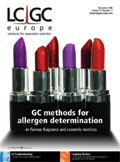Characterization of Triacylglycerides from Edible Oils and Fats using Single and Multidimensional Techniques
LCGC Europe
Sjaak de Koning1, Hans-Gerd Janssen2,3 and Udo A. Th. Brinkman4
1Leco Instrumente, Department of Separation Science, Mönchengladbach, Germany
2Unilever Research and Development, Advanced Measurement and Imaging, Vlaardingen, The Netherlands
3University of Amsterdam, van 't Hoff Institute for Molecular Sciences, Polymer-analysis Group, Amsterdam, The Netherlands
4Free University, Department of Analytical Chemistry and Applied Spectroscopy, Amsterdam, The Netherlands.
The main compounds present in oils and fats are triacylglycerides (TAGs). Characterization of these TAG mixtures can be performed in two ways: The analysis can focus either on the intact TAGs or can target the fatty acids (FAs) after hydrolysis of the TAGs. Column liquid chromatography (LC) is very powerful for group-type separation, whereas gas chromatography (GC), with its excellent separation efficiency, is more suited for detailed analysis. Two-dimensional chromatography offers two huge advantages relevant to edible oil analysis: It offers an unsurpassed peak capacity and provides an improved potential for group-type separation. The present study evaluates the performance of one- and (comprehensive) multidimensional chromatographic systems: AgLC, GC, AgLC×GC, GC×GC, AgLC×GC×GC. The best characterization of a TAG mixture is obtained by AgLCTAG×GCFAME×GCFAME with "chemical modulation" between the first and the second dimension. GCFAME×GCFAME can provide all the information required in the daily routine analysis of fat samples relatively rapidly (i.e., in about 2 h).
Edible oils and fats are an important part of the human diet. The main (group of) compounds present in oils and fats are the triacylglycerides (TAGs). A TAG molecule consists of three fatty acids (FAs) linked to the three hydroxyl groups of a glycerol molecule. Since the composition of the TAGs has important consequences for the final properties of a food product, both in terms of food structure and with regard to nutritional aspects, detailed analysis of the TAG composition of oils and fats is crucial.
Characterization of TAG mixtures can be performed in two ways: The analyses can focus either on the intact TAGs, or can target the FAs obtained after hydrolysis of the TAGs. In typical vegetable oils 'only' some 25 to 50 FAs are present at meaningful levels. In more complex animal fats or oils the number of FAs is easily as high as 100. While the separation of fatty acid mixtures containing such numbers of compounds can already be considered a challenge, the separation of the huge number of TAGs that can potentially be formed from such fatty acid mixtures is beyond our present means. Or in other words, whereas complete separation of the FAMEs (fatty acid methyl esters) can be achieved, TAG analysis has to be restricted to group-type separation according to the number of double bonds present in the TAGs or the total carbon-number distribution of the TAGs, for example.
One-dimensional chromatographic methods have been applied in oil and fat analysis for several decades. Column liquid chromatography (LC) is very powerful for group-type separations. Silver-phase LC (AgLC), for example, provides an excellent separation according to the number of double bonds present in TAGs.1 Because of the limited efficiency of LC, this technique is hardly used for more detailed analyses: the peak capacity is too low unless several columns are connected in series.2,3 Nevertheless, gas chromatography (GC), with its excellent separation efficiency is more suited for detailed analysis. Using long GC columns, typically 50–100 m, very complex mixtures of FAs can be resolved.4
In recent years, a new technique has become available that holds great promise for edible oil and fat analysis, which is comprehensive two-dimensional gas chromatography (GC×GC). This technique offers two huge advantages: It offers an unsurpassed peak capacity and provides an improved potential for group-type separation. In GC×GC the peaks eluting from the first-dimension GC column enter a cryogenic modulator, which traps each subsequent small portion of the eluate, focuses it and introduces it onto a second column for additional separation. The second separation is made sufficiently fast that on-the-fly introduction of eluate portions from the first- onto the second-dimension column is permitted. That is, the whole sample can be subjected to the two-dimensional separation in a single run. The stationary phase of the first-dimension GC column usually has a non-polar character, whereas the second-dimension column is somewhat polar. Under these conditions the separation of mixtures of homologues results in well-structured bands, more or less parallel to each other, showing up in the final 2D plot. However, since the second-dimension column needs to have a somewhat polar character, GC×GC cannot be used for the analysis of the intact TAGs. For TAG analysis, columns are required that are stable at high temperature, however, polar columns meeting that requirement are not commercially available. As regards TAG analysis, in recent work we have demonstrated that a significantly improved group-type separation can be obtained by means of comprehensive LC×GC.5,6 Anyway, after conversion of TAGs to FAMEs, the elution temperatures are much lower making GC×GC feasible. In literature several references were found dealing with GC×GC analysis of FAMEs,7–13 which show that highly detailed separations of complex marine fatty acid mixtures can be obtained with clear group separations according to chain length and number/positions of the double bonds.11 To avoid confusion, in the present paper we refer to GC×GC analysis of FAMEs as GCFAME×GCFAME. LCTAG×GCFAME indicates that TAGs are fractionated in the first (LC) dimension, which are then converted in a "chemical modulation step" to FAMEs that are analysed in the second (GC) dimension.
The ability of chromatographic separation systems to provide ordered group-type chromatograms in which compounds with similar properties align in bands or clusters has been discussed by Giddings who introduced the concept of "sample dimensionality",14 (i.e., the number of independent variables that must be specified to uniquely describe all components of a sample): The maximum number of separation dimensions required for a sample containing components differing in n dimensions is n. This concept is highly valuable when considering separations of FAs, which are characterized by four dimensions (Figure 1). They can vary in chain length, in the number of double bonds and their positions, and finally, the double bonds can be present in cis or trans orientation. According to Giddings' concept, for our four-dimensional FA mixtures a maximum of four independent separation mechanisms is necessary to achieve a complete characterization. Additional sample dimensions of TAGs are the total number of double bonds, the total carbon number (CN) and the positions of the FA(s) on the glycerol backbone, given by their stereospecific numbers, sn-1, sn-2 and sn-3. As for the last, the sn, dimension, it is known from the literature that a stereospecific — not chromatographic — method of analysis is required.15
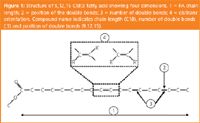
Figure 1
As a result of the extreme complexity of TAG samples it is essentially impossible to obtain a full characterization of all the TAGs in an edible oil or fat sample. Therefore, depending on the intended use of the data, chromatographic methods specifically focusing on one or a few sample dimensions are generally applied. As an example, for food labelling purposes the total concentration of saturated, mono-unsaturated, poly-unsaturated and trans FAs are needed. One dimensional GC analysis of FAMEs is typically used in this area, but the experimental results generally leave something to be desired.
The goal of the present study is to evaluate the performance of a number of single- and multiple (two- and three-) dimensional comprehensive chromatographic systems in terms of peak capacities and ability to give group-type separations of FA and TAG mixtures. The methods studied include AgLC, GC, GC×GC, AgLC×GC and AgLC×GC×GC. From amongst these, AgLC and GC are well known and commonly used for the analysis of edible oils and fats. For these techniques, conditions reported in the literature were used.16–18 The parameters for the multidimensional techniques were newly developed or were copied from recent publications of our group. The main aims are (i) to come to a total determination of the FA composition of TAGs and (ii) to answer the question whether it is possible, in the present instance, to use chromatographic systems of a lower dimensionality for the analysis of higher dimensionality samples. A summary of the performances of the individual methods will be given. As the main focus of this work is on chromatographic separation, no selective detectors such as a mass spectrometer were used. An evaporative light-scattering detector (ELSD) was used for AgLC and a flame ionization detector (FID) for GC.
Experimental
Test sample: Most experiments were performed using a partly hydrogenated vegetable oil. This sample is not very complex in terms of its FA chain-length distribution, it consists mainly of C16 and C18, or the number of double bonds per FA, 0–2. However, it is very complex in terms of double-bond positions and double-bond orientation. For some tests a control sample of interesterified palm oil was used to obtain additional information on the separation mechanism. For TAG analysis, 10 mg fat were dissolved in 1 mL of methyl tert.-butyl ether (MTBE). In the FAME analyses, two different procedures were used for FAME preparation:
- 5 μL of trimethylsulphonium hydroxide (TMSH) were manually added to 100 μL of the TAG sample in MTBE. After 1 min of agitation the FAMEs are ready for injection.
- FAMEs were also prepared by means of an automated sodium methylate procedure reported by de Koning et al.,19 where 10 mg fat were dissolved in 1 mL n-heptane. To this solution 100 μL of a 2 mol/L sodium methylate (NaOCH3) solution in methanol are added and the mixture is agitated for 1 min. The upper layer is then ready for injection.
Chemicals: MTBE was used to dissolve the test sample. Hexane, toluene, ethyl acetate and dichloromethane were used for the AgLC eluent (see Table 1 below). All solvents were of p.a. grade and were purchased from Merck (Darmstadt, Germany). Prior to use, eluents were dried using Mol sieve 5 Å. TMSH (Macherey-Nagel, Düren, Germany) and NaOCH3 (Merck) were used for TAG-to-FAME conversion.

Table 1: LC conditions for TAG separations.
AgLC: AgLC separations were performed on an Agilent 1100 LC system (Agilent Technologies, Wilmington, Delaware, USA). The column for AgLC of intact TAGs was a 10 cm × 4.6 mm i.d. column packed with 3 μm Ag(I)-loaded silica prepared according to Jeffrey16 and custom-packed by Varian (Middelburg, the Netherlands). The LC conditions for the separations are given in Table 1. Detection was done using an Alltech 500 evaporative light-scattering detector (Alltech Associates, Deerfield, Illinois, USA). The nebulizer temperature and drying gas flow were 50 °C and 1.7 L/min, following the in-house procedure.
GC: GC separations of FAMEs were performed on a Model 6890 GC (Agilent Technologies, Palo Alto, California, USA) equipped with a split/splitless injector, a Focus autosampler (ATAS GL, Veldhoven, The Netherlands) and a FID detector. Two types of column were used for (cis/trans) FAME analysis: a 50 m × 0.25 mm × 0.4 μm CP-Sil88 (cyanopropyl-based) and a 10 m × 0.15 mm × 0.2 μm CP-WAX 52 CB capillary column (Varian). Analysis on the CP-SIL88 column was performed isothermally at 176 °C, with helium as carrier gas at a constant pressure of 150 kPa, all optimized according to the procedure described in the AOCS method Ce-1f-96.20 For the analysis on the WAX column, the GC oven temperature started at 120 °C and was programmed to 155 °C at 15 °C/min where it was held for 6 min. Helium was used as the carrier gas, with a constant pressure of 250 kPa.17
The column used for CN analysis of intact TAGs was a 5 m × 0.53 mm i.d. Ultimetal SIMDIST column (Varian), with a film thickness of 0.17 μm. This column was operated in the constant-pressure mode at 50 kPa helium, which gave a column flow of approximately 13 mL/min. The column was programmed from 130 °C (0.5 min) to 380 °C (1 min) with ballistic heating. The total cycle time (heating and cooling) was approximately 6 min.
AgLC×GC: The AgLC system and conditions used for AgLC×GC were as described above, but for the comprehensive application, the system was operated in the stop-flow mode. Both AgLCTAG×GCTAG and AgLCTAG×GCFAME were performed.
For AgLCTAG×GCTAG, the conditions for the GC separation of the intact TAGs were the same as summarized above. Technical details on interfacing and fractionation are reported in references 5 and 6. Briefly, fractions eluting from the AgLC column are transferred directly into the GC injector via a specially designed side-port syringe. After the transfer of a fraction, the LC pump is stopped, the syringe withdrawn from the GC injector and the GC run started. When the GC is ready for the next run, the syringe is re-inserted into the GC injector and the LC pump restarted to transfer the next fraction.
For the AgLCTAG×GCFAME experiments the GC separation of the FAMEs was performed only on the CP-WAX column under conditions as summarized above. Here, the fractions eluting from the AgLC column are transferred to autosampler vials for transesterification of the TAGs to FAMEs. After the TAG-to-FAME conversion, the samples are injected into the GC system. Figures 2(a) and (b) give a schematic overview of the AgLCTAG×GCTAG and the AgLCTAG×GCFAME system. Although the latter system is not on-line, it is comprehensive because a representative part of the AgLC fraction is injected into the GC system.
GC×GC: All GC×GC experiments were performed on a Model 6890N GC (Agilent) equipped with a split/splitless injector (split ratio 1:100) and an FID detector. The instrument was equipped with a quad-jet cryogenic modulator (Leco, St Joseph, Michigan, USA) in front of a second-dimension oven (Leco), both installed inside the main GC oven. The column for the first-dimension separation housed in the main oven was a CP-WAX, 30 m × 0.25 mm × 0.25 μm (Varian). The column for the second-dimension separation, which was housed in the second-dimension oven, was a VF-23 ms, 3 m × 0.10 mm × 0.10 μm (Varian). Helium was used as the carrier gas at a pressure of 350 kPa. In all experiments, the first-dimension temperature programme started at 160 °C (hold 0.20 min) and was increased in 10 sec to 165 °C (hold 120 min). The second-dimension oven was kept at 165 °C during the entire analysis. The modulator was operated at 175 °C with a hot-pulse-time of 1 sec and a modulation period of 6 sec. GC×GC experiments were only performed for FAMEs because no suitable second-dimension column is available for TAG analysis as a result of the limited temperature stability of polar stationary phases. Control of the GC and the FID detector as well as data acquisition and processing was done using ChromaTOF (Leco) software.
AgLC×GC×GC: The AgLC×GC×GC system was a combination of the AgLC system operated in the stop-flow mode and the GC×GC system, both described above. For the reasons outlined above, only FAMEs were studied in the GC×GC part of this method. Figure 2(c) gives a schematic overview of the AgLCTAG×GCFAME×GCFAME system.
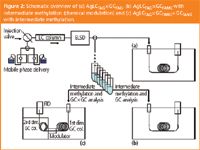
Figure 2
Results and Discussion
AgLC: As already mentioned in the Introduction, AgLC is an important technique in the characterization of edible oils and fats. This LC mode separates TAGs according to their number of double bonds, with some additional selectivity based on the sn-position of the unsaturated FAs on the glycerol backbone.21,22 The first eluting group are the fully saturated TAGs, indicated as SSS where S refers to all saturated FAs. The next group are the TAGs containing one unsaturated FA in the central position, sn-2. Trans unsaturates (SES) are less retained than cis unsaturates (SOS). Here E refers to all FAs containing one trans double bond and O to FAs with one cis unsaturation. The sn-2 mono-unsaturates are immediately followed by the TAGs with one mono-unsaturated FA in the sn-1 or sn-3 position (SSE and SSO). The next cluster of peaks represents the TAGs with one FA containing two double bonds and two saturated FAs. Again, the TAGs with the double-unsaturated FA in the sn-2 position elute before those having the unsaturated FA in the sn-1 or sn-3 position. Next to elute are the TAGs containing two FAs with one double bond each. Within this group unsaturation in both the sn-1 and sn-3 position causes later elution than a double bond in the sn-2 position and another one in the sn-1 or sn-3 positions, while the retention of trans double bonds is less than that of cis unsaturates. As an example, for TAGs with two mono-unsaturated FAs in the positions sn-2 and sn-1 or sn-3, the elution order is: SEE/SOE/SEO/SOO. To illustrate, Figure 3(a) shows the AgLC chromatogram of the reference palm oil sample, which also contains cis di-unsaturated FAs (i.e., SLS and SSL), but no trans isomers. AgLC is seen to give information about the total number and the orientation of double bonds in the FA chain as well as on the sn-position of the FA on the TAG backbone. However, real-life samples are often much more complex. This is clearly shown in Figure 3(b), which displays the AgLC chromatogram of the hydrogenated test sample. Beyond a retention time of 4–5 min, no reliable qualification is possible anymore because of the essentially continuous co-elution.
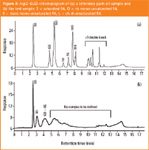
Figure 3
A summary of the present results, and also of those in the next sections, is given in Table 2 included in the Conclusions.

Table 2: Characterization potential of the chromatographic techniques of interest.
GC: GC is much more widely used in the characterization of edible oils and fats than LC. One approach is the analysis of intact TAGs on a non-polar column.16 Such a separation is mainly according to boiling point, which means separation according to CN (i.e., according to the sum of the chain lengths of the three FAs). As an illustration, Figure 4 shows the GCTAG–FID chromatogram of the test sample: Only one dimension is seen to be characterized. On polar phases some fine structure can be seen depending on the number of double bonds in the TAG,18 but separation is generally insufficient for reliable quantification.

Figure 4
Another widely used method in the GC analysis of oils and fats is the characterization of the FA chains. To do so, the TAGs are first converted into FAMEs by hydrolysis and methylation.23–26 Clearly, in this procedure all information on the TAG structure is lost. Figure 5(a) shows the GCFAME–FID chromatogram of our test sample on a CP-WAX 52 CB column. The peak designations indicate the position of the unsaturation (if present), the FAME chain length and the number of double bonds; there is no information on the cis/trans orientation of the double bonds. Elution is later for longer alkyl chains, with increased retention as a result of the number of double bonds and the position. The analysis of the same sample on a CP-SIL88 column is shown in Figure 5(b). The overall picture is the same as with the WAX column. However, now there is also information on the cis/trans orientation of the double bonds (indicated by c and t, respectively, in the peak designations). Double bonds and a double bond further away from the FAME head (higher position number) cause stronger retention. Cis isomers are more retained than the corresponding trans isomers.27 For simple samples, such as unprocessed vegetable oils, a very long cyanopropyl column (i.e., 100 m in length) can give a close to complete separation of all FAs present. However, in more complex situations (e.g., with processed oils or animal fat) co-elutions keep occurring and quantification of the individual FAMEs becomes difficult and imprecise, if at all possible. In the section below on GC×GC, the WAX and the cyanopropyl columns will be combined to create an improved cis/trans separation.

Figure 5
Multidimensional separations: In the preceding sections, the limited potential of 1D chromatographic methods to provide information on oil and fat composition has been briefly sketched. Conversely, it has also been shown that different techniques provide different types of information. Consequently, it lies at hand to combine two or more of these in a comprehensive set-up and attempt to obtain more — preferably all — information in one analysis. Comprehensive chromatographic techniques have proven to result in higher separation efficiencies28 and have demonstrated great potential for the characterization of "high sample dimensionality" samples.14,29,30 Given the clearly multidimensional nature of both TAGs and FAMEs, the use of such methods is anything but logical.
GC×GC: As mentioned in the Introduction, several papers discuss the comprehensive GC×GC analysis of FAMEs. One good example is the study by de Geus et al.11 However, this set-up did not give information on cis/trans orientation. As indicated in the section on GC analysis, a WAX column can be used to create separation in terms of FAME chain length and, in addition, the number and position(s) of the double bonds. Since cyanopropyl-based columns do effect a cis/trans separation, such a column was selected for the second-dimension separation in GCFAME×GCFAME. In 1D FAME analysis, cyanopropyl-based columns of 50 m or longer with an i.d. of 0.25 mm and a phase thickness of 0.25 μm are commonly used. However, such columns are not fast enough for second-dimension separations. Fortunately, since there is already a powerful pre-separation on the WAX column in the first dimension, cis/trans-isomer separation of individual compounds is all that is required in the second dimension. To keep the phase ratio the same as in conventional FAME analysis, we selected a 2 m × 0.1 mm i.d. VF-23ms column with a phase thickness of 0.1 μm. Several exploratory analyses, which were made using various combinations of temperature programming and second-dimension oven-offset temperatures somewhat unexpectedly showed that an isothermal analysis at 165 °C without any second-dimension oven offset gave a close to baseline separation of the cis/trans isomers. To bring this separation to perfection, the column length was increased from 2 to 3 m. The optimum column inlet pressure was calculated using the programme developed by Beens et al.31 To achieve the best possible separation in the second dimension this resulted, for the present column set, in a column head pressure of 350 kPa. Figure 6 shows the contour plot of the GCFAME×GCFAME analysis of the test sample. It is evident that chain length, number and position of the double bond and cis/trans orientation can be clearly distinguished. This will greatly improve the reliability of the quantification of the trans isomers.

Figure 6
As a result of the high peak capacity and orthogonal selectivity of the GC×GC system full characterization of the FAs in all four dimensions is obtained. All sample information required in the routine analysis of fats for labelling purposes is hence obtained within about 2 h.
AgLC×GC: AgLCTAG×GCTAG: As discussed above, AgLCTAG provides information on the number and sn position of double bonds. However, most real-life chromatograms are much too complex to provide unambiguous results. GCTAG was found to give full information on CN, but little else besides. Earlier, we comprehensively coupled these two techniques (AgLCTAG×GCTAG) and reported their fully automated operation.5,6 For both the AgLCTAG and the GCTAG system, the same conditions were used as mentioned before, the only difference being that the AgLC system was run in the stop-flow mode because GC is far too slow for on-the-fly modulation as used in GC×GC. Figure 7 shows the bubble plot obtained for the test sample. When running this analysis, the first 2.5 min of the AgLC separation was sent to waste. Subsequently, 15 sec fractions were transferred to the GC system to achieve information on the CN distribution of all peaks eluting from the AgLC column, which can be read from the Y axis of the figure. Here it must be noted that in contrast to conventional GCTAG analysis LCTAG×GCTAG provides information on the CN distributions obtained for each group of TAGs having the same double-bond characteristics. Unfortunately, no information is provided regarding the individual FAs.
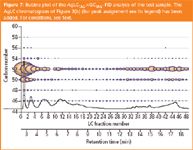
Figure 7
AgLCTAG×GCFAME: It is probably more rewarding to use an LC×GC approach to study the FA composition of one's sample in some detail. In this instance, interfacing is via so-called chemical modulation (cf. Figure 2). Chemical modulation implies conversion of the TAGs separated in the first dimension into FAMEs, which are then subjected to the second-dimension separation. The latter separation, performed on a WAX column (cf. GC section) provides information on the FA chain lengths, and also on the number and location of the double bonds. Figure 8 shows the AgLCTAG×GCFAME contour plot of our test sample. The insert is a blow-up of the area, which shows the separation of the C18:1 compounds and gives information on the position of the double bond. This is demonstrated by projecting the total contour plot on the Y axis, which gives the same chromatogram as that shown in Figure 5(a). An example of how to read the contour plot, is as follows. From the AgLCTAG retention time it is known that the vertical line drawn in the blow-up indicates the SES TAGs [Figure 3(b)]. The horizontal line indicates the 11 C18:1 FAs as can be derived from Figure 5(a). Combining the information shows that the FA in the intersection of the two lines is 11t C18:1. Although a WAX column is used here for the GC separation the information of cis/trans orientation can be derived from the information of the AgLC as the E from SES refers to trans mono-unsaturation.
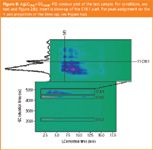
Figure 8
There is, of course, an alternative to the above procedure, which is to convert the TAGs into FAMEs before injection into the AgLC system (i.e., AgLCFAME×GCFAME). This approach was not included in this work. Previous studies showed that the technique can give valuable information on all four sample dimensions of the FAMEs,5,6 but the current GCFAME×GCFAME outperforms AgLCFAME×GCFAME in terms of speed (2 h versus 8 h). Moreover, structuring of the GCFAME×GCFAME chromatograms results in group-type separations and creates the means for rapid and accurate quantification. Finally, a distinct technical advantage is the on-the-fly modulation that can be realized much more easily in GC×GC than in AgLC×GC.
AgLCTAG×GCFAME×GCFAME: In the sections on GC×GC and AgLC×GC above it was demonstrated that comprehensive two-dimensional techniques effect the expected gain in separation power, especially GCFAME×GCFAME. Consequently, it seems worthwhile to go one step further and try a 3D separation for an even better characterization. The system tested was AgLCTAG×GCFAME×GCFAME which, again, includes chemical modulation in between the first (AgLC) and second (GC) dimensions. As an illustration, Figure 9(a) presents the GCFAME×GCFAME contour plot of the AgLCTAG peak of the test sample at 2.5 min [SSS peak of Figure 3(b)]. It is clear that this peak essentially contains only C16:0 and C18:0 FAs. Since the bubble plot of Figure 7 shows CN 52 to be predominant, one can calculate that the SSS peak is mainly composed of TAGs containing two C18:0 and one C16:0 FA(s). However, information on the sn positions of the FAs on the TAG backbone cannot be deduced. The GCFAME×GCFAME contour plot of the SES peak at approximately 3.5 min of Figure 3(b) displayed in Figure 9(b) clearly shows that there are no cis FAs in this AgLCTAG peak. As only trans C18:1 FAs are found and knowing the fraction is from an SES peak, it is certain for all TAGs in this peak that the sn-2 position is always a trans C18:1 FA. In addition, Figure 7 shows that also for this peak CN 52 predominates. Combining the information from Figures 7 and 9(b) indicates that for the most abundant TAGs, sn-1 is C16:0, sn-2 is trans C18:1, and sn-3 is C18:0. This shows that AgLCTAG×GCFAME×GCFAME can occasionally provide some stereospecific information. Figure 9(c) is the GCFAME×GCFAME contour plot of the AgLCTAG peak from Figure 3(b) at approximately 13 min. In this plot, a C18:2 FA also shows up. Since this fraction is a combination of all TAGs with three and more double bonds (which cannot be separated by AgLC) it is highly complex. In other words, even 3D comprehensive chromatography now does not provide sufficient selectivity.

Figure 9
Conclusion
Seven one-dimensional and comprehensive multidimensional separation techniques were studied to reveal their potential for the characterization of a partly hydrogenated vegetable oil in terms of sample dimensionality. One positive conclusion is that combining several 1D techniques in a more complicated comprehensive set-up, does not cause any loss of performance. In other words, the potential of the 2D and 3D techniques can reliably be predicted from those known from the underlying 1D methods.
As regards the characterization of the oil sample, not unexpectedly, Table 2 shows that best characterization in terms of sample dimensionality is obtained by AgLCTAG×GCFAME×GCFAME, which gives information on six out of the seven sample dimensions within the scope of the present approach (and, occasionally, even on the sn positions of the TAGs). For information on the CN distributions of each group of TAGs having the same double-bond characteristics, an additional AgLCTAG×GCTAG analysis is required. Giddings' concept is seen to be met: five chromatographic dimensions suffice to characterize seven dimensions of the sample.
The novel GCFAME×GCFAME method shows a much better separation than is available in the literature. It allows an easy classification, in terms of the total concentrations of saturated, mono-unsaturated, poly-unsaturated and trans FAs. That is, Giddings' concept is again met, with only two dimensions being needed to characterize the four sample dimensions of the FAs. To put it differently, all sample information required in daily practical analysis for food labelling purposes can be obtained in the relatively short analysis time of 2 h. Admittedly, AgLCTAG×GCFAME×GCFAME analysis of a complex TAG would be more powerful, but typically requires 36 AgLC fractions to be subjected to approximately a 2 h GCFAME×GCFAME run each. The total time needed in this instance is, therefore, some 72 h.
Sjaak de Koning is senior application chemist for Leco Instruments, department of separation science, in Mönchengladbach, Germany and a PhD student of Professor U.A.Th. Brinkman at the Free University, department of Analytical Chemistry and Applied Spectroscopy, Amsterdam, The Netherlands. He obtained his masters degree in 1996 in analytical chemistry from the Free University. His research includes sample preparation and multidimensional separation techniques.
Hans-Gerd Janssen is the group leader of chromatography and mass spectrometry at Unilever Research and Development Vlaardingen, The Netherlands. He is also a part-time professor at the University of Amsterdam. He obtained his masters degree (1987) and PhD degree (1991) in analytical chemistry from the Eindhoven University of Technology, The Netherlands. His research interests include food analysis, the separation of biomacromolecules and chromatographic techniques.
Udo A.Th. Brinkman is emeritus professor of analytical chemistry at the Free University, Amsterdam, The Netherlands. His current research activities are in the fields of multidimensional separation methods and the use of hyphenated techniques, with special emphasis on comprehensive gas chromatography (GC×GC) and its many applications.
Column Editor, Robert Smits, is the secretary general of the Koninklijke Vlaamse Chemische Vereniging (Royal Flemish Chemical Society). He is Chairman of the biennial "International Symposium on Hyphenated Techniques in Chromatography and Hyphenated Chromatographic Analysers" and a member of the Editorial Advisory Board of LCGC Europe.
References
1. P.J.W. Schuyl et al., J. Chromatogr. A, 810, 53 (1998).
2. J. Fritsche et al., Fett/Lipid, 101, 272 (1999).
3. N. Sehat et al., Lipids, 34, 407 (1999).
4. P. Juaneda, J. Chromatogr. A, 954, 285 (2002).
5. S. de Koning et al., J. Sep. Sci., 27, 397 (2004).
6. H.-G. Janssen, S. de Koning and U.A.Th. Brinkman, Anal. Bioanal. Chem., 378, 1944 (2004).
7. E. Jover et al., J. Chromatogr. A, 1086, 2 (2005).
8. M. Adahchour et al., J. Chromatogr. A, 1086, 128 (2005).
9. M. Kallio et al., J. Chromatogr. A, 1019, 251 (2003).
10. T. Hyötylaïnen et al., J. Sep. Sci., 27, 459 (2004).
11. H.-J. de Geus et al., J. Chromatogr. A, 910, 95 (2001).
12. R.J. Western et al., Lipids, 37, 715 (2002).
13. L. Mondello et al., J. Chromatogr. A, 1019, 187 (2003).
14. J.C. Giddings, J. Chromatogr. A, 703, 3 (1995).
15. H.-G. Janssen et al., J. Chromatogr. A, 1112, 141 (2006).
16. B.S.J. Jeffrey, J. Am. Oil Chem. Soc., 68, 289 (1991).
17. W. Boers et al., Lipid Technol., 87, July 2000.
18. E. Geeraert and P. Sandra, J. Am. Oil Chem. Soc., 64, 100 (1987).
19. S. de Koning et al., J. Chromatogr. A, 922, 391 (2001).
20. AOCS Official method, Determination of cis- and trans-Fatty Acids in Hydrogenated and Refined Oils and Fats by Capillary GLC, Ce-1f-96, 1997, Champaign, Illinois, USA.
21. L.J. Morris, J. Lipid Res., 7, 717 (1966).
22. V. Ruiz-Gutierrez and L.J.R. Barron, J. Chromatrogr. B, 671, 133 (1995).
23. W.W. Christie, Inform, 3, 1031 (1992).
24. E. Schulte and K. Weber, Fat Sci. Technol., 91, 181 (1989).
25. AOCS Official method, Sampling and analysis of commercial fats and oils, Ce-2-66, 1969, Champaign, IL, USA
26. NEN 3724, Butter and butter-oil. Physical and chemical test methods. Gas chromatographic determination of fat from butter and butter-oil, Rijswijk, The Netherlands, 1976
27. E. Balleros, M. Gallogo and M. Valcárel, Anal. Chim. Acta, 282, 581 (1993).
28. J. Dallüge, J. Beens and U.A.Th. Brinkman, J. Chromatogr. A, 1000, 69 (2003).
29. V.G. van Mispelaar, H.-G. Janssen and A.C. Tas, P.J. Schoenmakers, J. Chromatogr. A, 1071, 229 (2005).
30. R. Edam et al., J. Chromatogr. A, 1086, 12 (2005).
31. J. Beens et al., J. Chromatogr. A, 1086, 141 (2005).
Polysorbate Quantification and Degradation Analysis via LC and Charged Aerosol Detection
April 9th 2025Scientists from ThermoFisher Scientific published a review article in the Journal of Chromatography A that provided an overview of HPLC analysis using charged aerosol detection can help with polysorbate quantification.
Analyzing Vitamin K1 Levels in Vegetables Eaten by Warfarin Patients Using HPLC UV–vis
April 9th 2025Research conducted by the Universitas Padjadjaran (Sumedang, Indonesia) focused on the measurement of vitamin K1 in various vegetables (specifically lettuce, cabbage, napa cabbage, and spinach) that were ingested by patients using warfarin. High performance liquid chromatography (HPLC) equipped with an ultraviolet detector set at 245 nm was used as the analytical technique.
Removing Double-Stranded RNA Impurities Using Chromatography
April 8th 2025Researchers from Agency for Science, Technology and Research in Singapore recently published a review article exploring how chromatography can be used to remove double-stranded RNA impurities during mRNA therapeutics production.

